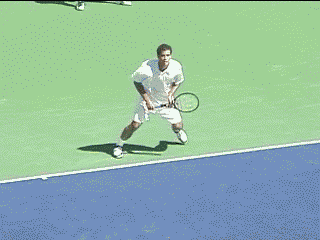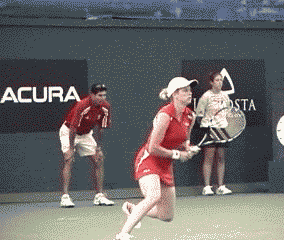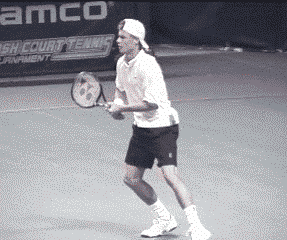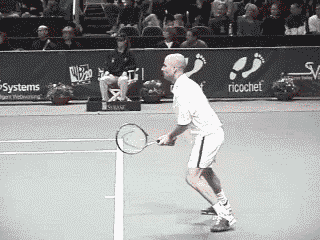|
TennisOne Lessons Extreme Tennis Makeover: The Backhand David W. Smith, Senior Editor TennisOne Over the past number of years, there have been a plethora of “Makeover” shows; from fashion to body parts, from cars to homes -- it seems people are recognizing the need to start over. Why this has become such a phenomenon is open to debate but, one can’t dismiss the notion that at some point, a person can’t simply put a “band aid” on a problem and hope it will solve the issue. No truer is this than in the game of tennis. We have seen dozens of teaching pros tout everything from the aforementioned “band aid” solutions to “quick fixes” to “ten tips to better tennis in ten minutes” to gimmicks that are advertised to correct some flawed aspect of one’s game. Such approaches to improvement are often based on providing temporary solutions or improvising the use of a flawed technique, grip, swing pattern, or footwork. It is often an unwritten or unspoken revelation: You can’t learn tennis right, so here is a way to make your current methods a little more successful. And it comes as no surprise: a large percentage of long-time players refuse to make significant changes in their game perhaps because they don’t recognize they are using flawed techniques, they simply believe they are incapable of using more advanced methods, or they are unwilling to sacrifice a few victories today for much greater future successes. There is a common anecdote in the tennis teaching profession that adequately describes such players: A 60 year old player, one who has been playing a long time, comes to his or her new teaching pro for a lesson and says, “Here’s my fifty dollars. Now don’t change a thing.” Ironically, these players want to improve; they attend clinics, lessons, camps and workshops, read books and watch tennis videos, and study tennis-related websites. Yet, when it comes to learning or employing new methods, there is an almost antagonistic refusal to hearing why they should learn something new, let alone work at developing something different! It is obviously critical for anyone, beginner or seasoned club player, to recognize what is limiting them, (if indeed, they have been stuck at a certain level for at least a year), why it is limiting them, and what methods will open the door to greater, long-term improvement. Natural Versus Unfamiliar Recently, I read a forum question about how to train some beginner adults using the two-handed backhand, which, the writer said was being resisted by his students; “It felt more natural to use one hand on the backhand” was the general consensus. A response I read to this post asked, “If they all instinctively use a one-handed backhand, why not try to develop that, why push them to a two-handed backhand?” Let me try to discuss this by first offering an analogy: Any newcomer to playing the piano will instinctively play the piano with two index fingers, having no instructional input. Golfers will instinctively swing the golf club like a baseball bat or other implement if not taught the grip, arm position, and stance associated with a golf swing. We can recognize what we could term “mediocre” in nearly any activity, sport, musical instrument, etc. Likewise, we can all identify those who are accomplished and skilled in each of these activities. What differentiates these differences?
The point here is that most players who initially try tennis will not try using two hands on a stroke or use more effective grips. In addition, the vast majority of beginners who do use one-handed swings will use very suspect form at best. Those who are taught tennis strokes using a one-handed backhand usually have great difficulty in creating and using proper swing mechanics. While there are many exceptions, my experience is that no matter where the student is taught, only a few will master a skillful one-handed backhand initially, and many can develop such bad habits that they risk developing tennis elbow at worse, or becoming a dinker at best. Two hands, without a question, helps players develop a sound topspin backhand, one that helps establish a reliable, repeatable swing pattern that is usually far more effective and consistent than those players who learn with one hand. All you have to do is go to your local club or public court and watch all the life-long 3.0 or 3.5 level players hacking and pushing their one-handed backhands. It is no surprise that the vast majority of skilled players--from pros to college players to top-ranked juniors--use two hands on their backhands. And, ironically, a great percentage of pros who do have a skilled one-handed backhands started learning with two hands. The Extreme Makeover I can only assume that the vast majority of people reading these articles will be players looking for ways to improve their games and I can assure you that such a goal is within the reach of all. This series will document the processes and procedures that anyone, from a beginner to a seasoned tennis-playing adult, can employ. Think of it as a blueprint for reaching your true potential. Extreme Makeover: The Backhand Understand that the process of change will include not just technical advice, but exercises to help you acquire the necessary technique, psychological aspects of mastering the change, and tools to help insure that the change becomes permanent. This last element is very important because anytime a change is attempted, there is a strong compulsion to revert back to that which is most familiar especially under stressful situations like match play. This is the first psychological and physiological wall a player must understand and breakthrough if he or she is to succeed in mastering something new. First Step: The Swing Path The development of the swing path—in other words, what your racquet is doing during the stroke—is the first and foremost step to improving. I know there are those who emphasize footwork as a priority, and I won’t argue the importance of this aspect. However, no matter how well you get to a ball, if your stroke is flawed, the ball will seldom behave the way you intend it to. In addition, there are millions of senior players who, no matter what, won’t be able to improve their speed, quickness, or endurance a whole heck of a lot! So understanding the swing path will be the most effective road to success.
When trying to change a particular stroke, under stress, a player will inevitably revert back to the old stroke especially if the two shots are too closely related. In such situations, I recommend adopting a totally new stroke which develops new stroke patterns. Learning a two-handed stroke often provides this sense of newness for one-handed players. Players who still will want to use a one-handed stroke, can usually transition successfully to the one-handed backhand later after re-tooling their backhand using two hands. The grip for the two-handed backhand should be continental for the dominant hand and a strong eastern forehand grip for the non-dominant hand. The fact that the dominant hand uses a continental grip should help players develop a continental-based slice backhand and feel more comfortable hitting backhand volleys and slices strokes, using the continental grip. This was apparent at this year's U.S. Open where two-handed players like Nadal, Roddick, and Fish relied heavily on the sliced backhand. The swing path for the backhand makeover should start with the straight-back backswing, with the racquet head pointed down, the hands down by the hips. This pattern (eventually most players will naturally evolve into some kind of loop) is still used by a number of pros including the William Sisters and Lleyton Hewitt. (Please see my article “Evolving a Loop Swing That Fits” for more on this concept of evolving your loop swing.)
From this starting point, players can easily develop a smooth, reliable, repeatable topspin swing path by keeping the plane the same throughout the stroke. Other key position points include keeping the dominant arm’s elbow close to the side of the player through contact. After contact, the arm will be free to move away from this position as the natural follow-through allows. Also, maintaining an imaginary straight line from the elbow of the dominant arm through to the tip of the racquet, from backswing to well past follow-through, helps a player again establish a repeatable stroke, helping prevent the wrist from snapping the racquet over the forearm. The follow-through will finish over the dominant shoulder, with the non-dominant arm’s elbow pointing towards the target; the butt-cap of the racquet also pointing to the target; and, the non-dominant arm’s bicep ending up right by the chin of the player.
Footwork Footwork for any stroke should be understood in two main points: the first being the ability to get to the ball in a balanced, controlled position; the second, the ability to stroke the ball using optimal footwork patterns for the situation. I recommend a closed stance for developing the topspin two-handed stroke. From this footwork pattern, the player will learn to hit without opening up too early, (as many will do if they learn an open stance footwork pattern first). The player will want to make sure of two things dealing with footwork during the stroke: The first is to keep the back foot or toe down through contact. The biggest problem for many is they swing the foot and subsequent body around with the racquet during the stroke. This will cause the player to pull the ball out wide and unconsciously “push” the ball to correct this perception. The other element of footwork is to keep from leaning back during contact and pulling the front foot away from the stroke. While both these patterns actually can become part of the stroke in more advanced situations, the propensity of players developing bad habits, (by trying to do them when working on the stroke), is very likely. Tools There are many tools that can help a player develop a proper swing path and stroke. The first I recommend is the PracticeHit which is a foam ball perched upon a fiberglass shaft and is allowed to be hit and have the ball and shaft oscillate with various adjustable speeds. The reason I like this device best is that it allows a player to hit a ball without worrying about where the ball goes. (You can learn more about the PracticeHit at www.practicehit.com.) Because players will almost always change their stroke to accommodate a feeling of where they want the ball to go, (instead of changing the timing or rhythm of the stroke to accommodate the aim), hitting live balls will often result in undesirable swing patterns sneaking into the stroke. Another recommendation is to shadow swing in front of a mirror. Again, when we are hitting a tennis ball, we lose consciousness of what our racquet is doing on our backswing. If the stroke is not established first, the player often takes a different backswing than what they are trying to accomplish. By practicing in front of a mirror, the visual recognition of your stroke is more permanently embedded into your muscle memory.
There are many additional teaching/learning aids you can purchase from sites such as Joe Dinofer’s www.oncourt-offcourt.com that can help develop proper arm positions, grips, and footwork patterns. Progressions After the stroke feels comfortable and competent using the tools mentioned above, have someone drop-feed balls to the backhand. This allows the player to work on the right swing path when hitting a ball towards a target. Drop-feeding allows a player to work on the feel of the spin and swing path relative to hitting the ball on a specific trajectory and target, without having to negotiate the timing of an on-coming ball. This is one of the biggest mistakes adults make when trying to teach kids. Tossing balls to kids will decrease their awareness of the desired stroke and put them into a completely different mindset, that of simply trying to hit the ball. While we will eventually move on to this important progression of hitting balls that are coming towards us, at this point it is to common to see players abandon the stroke they are working on when faced with the complications of negotiating the depth, bounce, and spin of an on-coming ball.
The second progression includes balls tossed from a short distance to the student. The idea is to have the student work on changing the ball’s direction without changing the stroke pattern. Learning to change the timing of the stroke and the relationship to the body for going down the line or crosscourt, is important to do without the player feeling like they need to change the swing pattern. The next step is to employ some movement to the ball. This can actually be done first with the aforementioned PracticeHit by starting further away from the device and move to it then executing the stroke using proper footwork and balance. Again, once the swing is mastered, then a student can work on moving properly to a tossed ball in a controlled situation. One of the best learning tools at this stage is to remember the phrase: “Hit and Hold.” This phrase refers to the player making the stroke, but holding the balance and finish for a moment before recovering back to the ready position. This idea really helps players develop balance and aim as it helps create a full beginning and end to each shot. Watch the pros and see if you can spot them holding their finish for a brief moment. It is this aspect, perhaps more than any, which creates the identification of seeing pros hit with essentially the same, exact foundation, even as they all have their own personalities and idiosyncrasies in their strokes. Conclusion There are many articles in the TennisOne Lesson Library which you can pull up and find many other tips and stroke elements. The idea of this series is to lay out the basic foundation for you, or anyone, to develop a better stroke, one that will allow the player to have continued improvement and progressive success in the process. (Click link to purchase Dave Smith's newest Book Coaching Mastery, at tenniswarehouse.com or go to www.coaching-mastery.com for more information and order a personalized autographed copy direct from the author. Your comments are welcome. Let us know what you think about Dave Smith's article by emailing us here at TennisOne .
|





